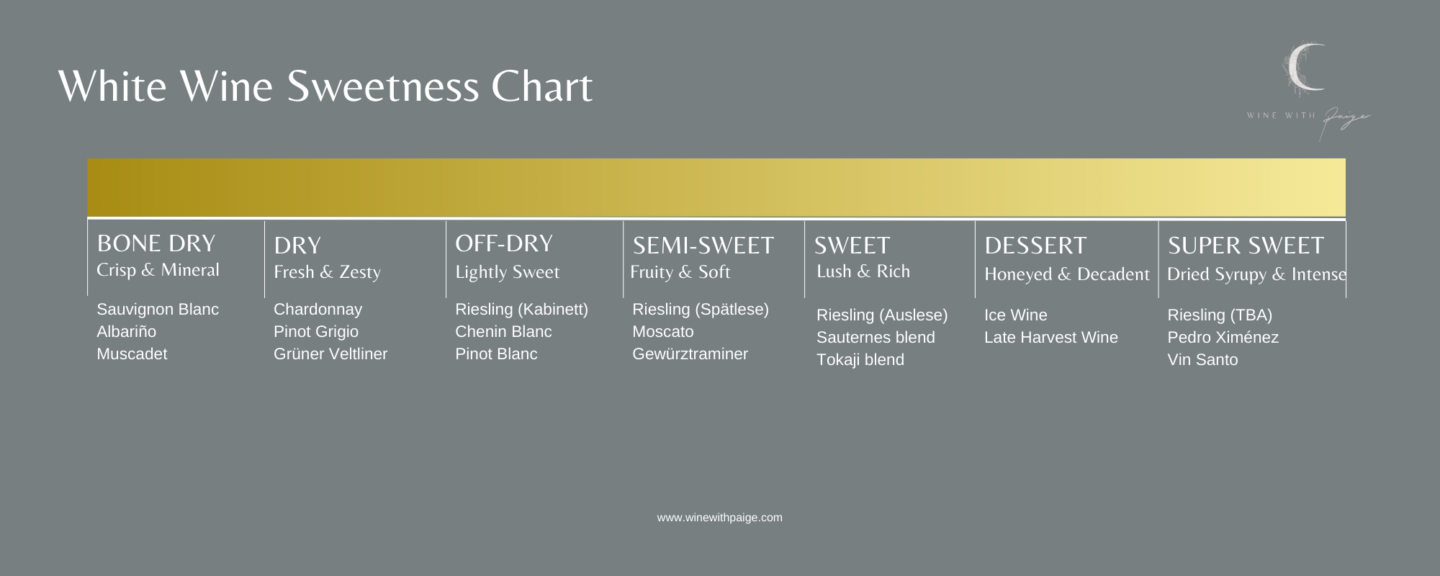
Is Chardonnay Dry, Sweet, or Somewhere in Between? Unraveling the Chardonnay Mystery
Chardonnay, the quintessential dry white wine, often finds itself at the center of a taste debate: Is Chardonnay sweet, is it dry, or does it inhabit a delightful middle ground? Let’s embark on a journey through the world of Chardonnay to uncover the secrets of its sweetness, dryness, and everything in between.
White Wine Sweetness Chart

Chardonnay: A Versatile White Wine
Before we dive into the sweetness spectrum, it’s crucial to understand the essence of Chardonnay.
Chardonnay Basics
- Chardonnay is a globally beloved white grape variety originating from Burgundy, France.
- It’s prized for its adaptability, thriving in various climates and terroirs.
- Chardonnay is one of the world’s most popular white wines, celebrated for its diverse styles.
Now, let’s tackle the age-old question…

Is Chardonnay a Dry Wine?
The answer, as you may have guessed, isn’t as straightforward as a simple “yes” or “no.”
Chardonnay Styles: Decoding the Sweet vs. Dry Debate
Chardonnay’s taste and sweetness, or lack thereof, hinges on the winemaking style. Let’s explore the two primary Chardonnay styles:
Oaked Chardonnay: The Rich and Buttery Elegance
Flavor Profile: Oaked Chardonnay is known for its opulence and depth. It often showcases lush, creamy, and buttery flavors. These wines are characterized by ripe fruit notes, including tropical fruit flavors like pineapple and mango, as well as ripe apple and pear.
Sweetness Level: Oaked Chardonnay can range from bone dry to slightly off-dry. While they may not be overtly sweet, some oak-aged Chardonnays may have a subtle residual sugar presence, contributing to a rounder mouthfeel.
Unoaked Chardonnay: The Crisp and Refreshing Alternative
Flavor Profile: Unoaked Chardonnay takes a different path, emphasizing crispness and fruit purity. In this style of Chardonnay, you’ll encounter flavors like green apple, citrus, and minerals. These wines are light, fresh, and often vibrant.
Sweetness Level: Unoaked Chardonnay tends to be on the drier side of the spectrum. They are typically considered dry white wines, with little to no detectable sweetness.
So, Is Chardonnay a Sweet Wine?
The answer is no, Chardonnay is not typically considered a sweet wine. However, there are exceptions, such as late-harvest Chardonnays, dessert wines, or those with specific winemaking techniques that may result in slightly sweet variations.
The majority of Chardonnays fall into the dry category.

Comparing Chardonnay to Other White Wines
To better understand where Chardonnay grapes stand in terms of sweetness, let’s compare it to some other popular white wines.
Chardonnay vs. Pinot Grigio
Chardonnay tends to be richer and more fruit-forward compared to the typically crisp and light Pinot Grigio.
Pinot Grigio is often considered a dry white wine, leaning towards the drier end of the spectrum.
Related: Pinot Grigio vs Chardonnay
Chardonnay vs. Riesling
Riesling is known for its versatility, ranging from bone dry to intensely sweet.
Chardonnay is generally drier than Riesling, with only occasional exceptions for off-dry versions.
Chardonnay vs. Sauvignon Blanc
Sauvignon Blanc is renowned for its zesty acidity and herbaceous notes.
Chardonnay offers a more rounded and less acidic profile, usually with a drier taste.
Related: Sauvignon Blanc vs Chardonnay

How to Determine Chardonnay’s Sweetness
Understanding Chardonnay’s sweetness can be crucial when selecting a bottle that suits your taste. Here’s how to gauge a Chardonnay’s sweetness level:
Check the Label
Look for clues on the label, such as terms like “dry,” “off-dry,” or “sweet.” Winemakers often provide these hints.
- Dry: This indicates that the wine has minimal residual sugar, typically less than 10 grams per liter (g/L). Dry wines have little to no perceptible sweetness.
- Off-Dry: These wines have a moderate level of residual sugar, typically between 10 to 35 g/L. They may have a hint of sweetness but are not considered fully sweet.
- Sweet: Wines labeled as “sweet” or “dessert” wines have a higher sugar content, often above 35 g/L. These wines are noticeably sweet and are often served as dessert or with sweet dishes.
Research the Winemaker
Explore the winemaker’s style. Some wineries are known for producing wine in a dry style, while others may lean towards a more off-dry or sweet profile.
Ask Your Sommelier or Wine Retailer
Don’t hesitate to seek guidance from wine professionals. They can provide insights into specific Chardonnay bottles. I promise most are friendly and excited to help!
The Chardonnay Sweetness Myth: Busted!
In conclusion, Chardonnay is not inherently a sweet wine. Its sweetness level varies depending on the winemaking style, with oaked Chardonnay showcasing a wider range, from dry to slightly off-dry, while unoaked Chardonnay tends to be drier.
Understanding these distinctions allows you to explore the diverse world of Chardonnay with confidence.
So, the next time you’re pondering the Chardonnay sweet or dry question, remember that it’s a versatile grape capable of producing a spectrum of delightful flavors.
Cheers to your exploration of Chardonnay wines! 🥂
